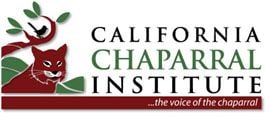California Chaparral Institute
"Nature is an incomparable guide
if you know how to follow her."
- Carl Jung
Protecting What's Left
The California Chaparral Institute is a 501(c)(3) nonprofit environmental organization founded in 2004 that's dedicated to protecting the biotic and geological wonders of California's chaparral biome - the state's most characteristic, yet most imperiled, native shrubland ecosystem. Through Nature education, scientific research,
and engaging conversations,
we strive to be the voice of the chaparral
and all the life it supports.
What's Chaparral?
Chaparral is California's most distinctive wildland. Characterized by drought-tolerant, woody shrubs, high intensity, infrequent fire, and shaped by a Mediterranean-type climate (hot, dry summers & mild, wet winters), chaparral covers most of California's coastal foothills and interior mountain slopes. Grouping together the various chaparral plant community types along the west coast of North America forms the California Chaparral Biome. Check out our Chaparral Page for more detail on California's remarkable native shrublands.
Our Mission
To promote an understanding of and appreciation for the chaparral and the geological foundation upon which it thrives to:
- Foster connections with Nature and the creative spirit it can inspire.- Inspire an appreciation for the biological and geological wonders of the
chaparral ecosystem.- Reconcile our modern existence with Nature to enhance our lives.- Create and promote a new Nature-centered, engaging education model that will
foster intellect, inspiring conversations, and richer lives.
The only way to heal behaviors that damage the environment and ourselves is to address their actual cause - our disassociation from Nature and the self, and the resulting alienation from each other.
Despite civilization's influence, our ties to Nature remain strong as evidenced by the positive impact of spending time outdoors surrounded by the green felt of plant life, the conversations of birds, insects, and frogs, the fragrance of sage, and the curious nature of twisted rock layers and magnificent boulders. With an open heart, Nature can foster a reconnection with the innocent, wild self that dwells within each of us. As that connection becomes stronger, it becomes increasingly easy to enjoy life, discover the infinite possibilities we have within, and to view the natural environment as an integral part of who we are.
Nature provides a path to recognize, acknowledge, and heal psychological patterns that do not serve us. By losing ourselves in Nature, we can find ourselves.
Despite civilization's influence, our ties to Nature remain strong as evidenced by the positive impact of spending time outdoors surrounded by the green felt of plant life, the conversations of birds, insects, and frogs, the fragrance of sage, and the curious nature of twisted rock layers and magnificent boulders. With an open heart, Nature can foster a reconnection with the innocent, wild self that dwells within each of us. As that connection becomes stronger, it becomes increasingly easy to enjoy life, discover the infinite possibilities we have within, and to view the natural environment as an integral part of who we are.
Nature provides a path to recognize, acknowledge, and heal psychological patterns that do not serve us. By losing ourselves in Nature, we can find ourselves.
Please join us to help support our mission by becoming a member!
To stay informed and learn more about
the remarkable chaparral ecosystem, please add your name to our mailing list.
Our Story
The California Chaparral Institute was established shortly after the 2003 Cedar Fire in San Diego County, the 273,000 acre wildfire that marked the beginning of the California's new era of catastrophic mega fires.
During and after the Cedar Fire, chaparral was inaccurately blamed as the cause of the fire’s devastation. San Diego County government responded to this misperception by proposing a program to clear 300 square miles of backcountry habitat. After six years of involvement by the Institute and others to help the county develop a new fire risk reduction plan based on science, the county proceeded with their original program. The program was dropped after the Institute successfully challenged it in court.
Since 2003, the Institute has produced publications and provided hundreds of public presentations explaining the value of the chaparral ecosystem and how we can live safely within California’s fire-prone environment. The Institute has also coined several popular concepts shortly after the 2003 Cedar Fire to help promote science-based fire safety and an appreciation for the chaparral including reducing fire risk in our communities “from the house out rather than from the wildland in” and identifying legacy chaparral stands over 50-years-old as “old-growth chaparral.”
Chaparral now is more commonly recognized as an important part of California's natural environment. The US Forest Service issued a major policy statement in 2013 recognizing the value and fragility of the chaparral and has held several symposia focusing on the ecosystem services it provides. New publications are also helping the public recognize and appreciate the chaparral.
Still, much work still needs to be done as many agencies such as Cal Fire, and even some environmental non-profits, see wildness as a frightening thing that needs to be cleared, especially when millions of dollars in grant money are available to do so. Such behavior demonstrates the artificial distance between people and Nature remains a powerful force. Consequently, the California Chaparral Institute continues to focus on helping to bring the wonder of Nature back into people's lives through innovative educational programs, research, and outdoor experiences. The greater awareness of and appreciation for the wild, natural environment, the greater number of voices there will be to speak up for its protection.
